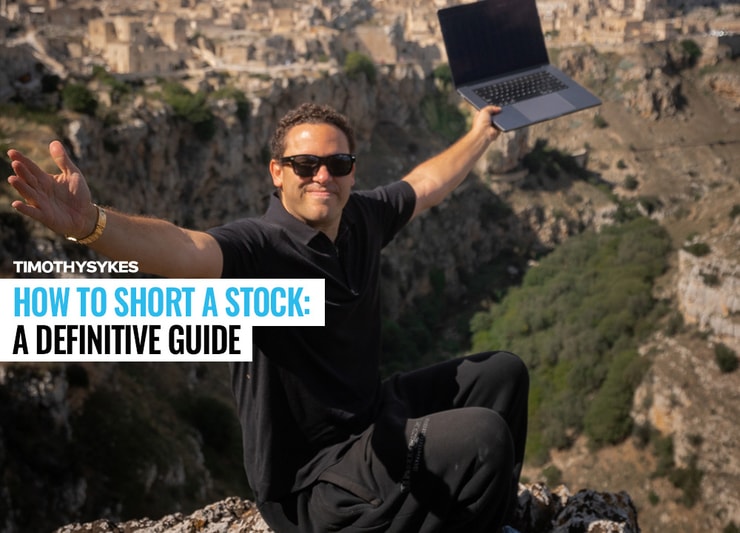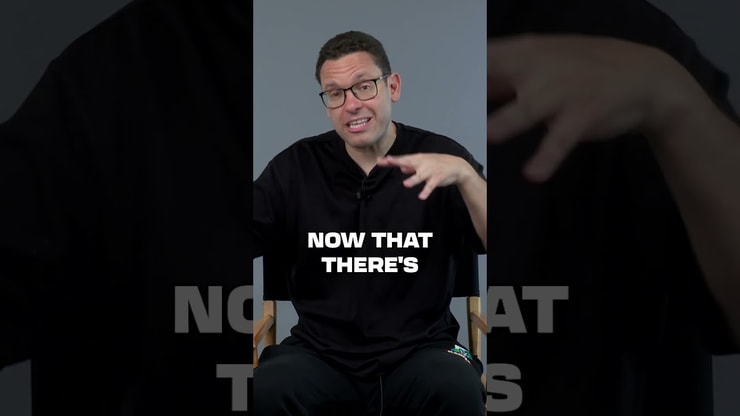Shorting a stock is the act of betting against a company’s share price, expecting it to decline. In this strategy, you borrow shares to sell them at the current market price, with the intention of buying them back at a lower price later.
You should bookmark this guide because it covers the ins and outs of shorting a stock, including the potential benefits and risks, as well as a step-by-step example.
We’ll cover the following questions …
- What is short selling and how does it differ from going long on a stock?
- How can short selling be profitable and what are the risks involved?
- What are the steps to short a stock with TD Ameritrade?
- Can you short a stock on E-Trade or Robinhood?
- What costs are associated with short selling, such as margin interest and stock borrowing costs?
- How can short selling be used as a hedge against potential losses?
- What are some tips for effective short selling?
Let’s get to the details!
Table of Contents
- 1 What Is Short Selling?
- 2 Why Sell Short When it Can Involve Unlimited Losses?
- 3 How to Short A Stock
- 3.1 How to Short with Options
- 3.2 7 Steps to Shorting a Stock (with TD Ameritrade as an Example)
- 3.2.1 1. Enable Your Account for Margin Trading
- 3.2.2 2. Enter Your Order to Sell Short
- 3.2.3 3. Account Minimum
- 3.2.4 4. Stocks That Can’t Be Traded by TD Ameritrade
- 3.2.5 5. How Long it Takes to Enable Your Account for Short Sales
- 3.2.6 6. You Can’t Reserve Shares to Short
- 3.2.7 7. TD Ameritrade Short Selling Fees
- 4 How Do You Short a Stock on E-Trade or Robinhood?
- 5 Costs of Short Selling
- 6 Best Trading App for Short Selling
- 7 4 Short Selling (Shorting) Tips
- 8 Short Selling: Potential Benefits and Risks
- 9 Trading Challenge
- 10 Can Anyone Short Sell a Stock?
- 11 The Bottom Line
- 12 FAQs
- 12.1 What Is a Short Squeeze?
- 12.2 Why Do Short Sellers Have to Borrow Shares?
- 12.3 Can I Sell Short in My Brokerage Account?
- 12.4 What Financial Entities Are Involved in Shorting Stocks?
- 12.5 Does Jurisdiction Affect My Ability to Short a Stock?
- 12.6 What Should I Look for in Client Advisories?
- 12.7 What Are Some Investment Products Related to Shorting Stocks?
- 12.8 Where Can I Find an Overview and Examples of Shorting?
What Is Short Selling?

Before I explain short selling, let’s do a brief refresher course on trading in the stock market …
A long position is the opposite of a short position.
When you go long on a stock, you buy shares at a particular price point because you believe the stock price will increase. If the price moves in the direction you anticipated, you can sell your shares in that stock at the higher price point and make a profit.
A short position is an alternative to going long, where you’re not the owner of the stock. You short sell because you think a stock’s price will decline over a specific period of time.
Short selling involves borrowing and selling shares with the aim to buy them back at a lower price, profiting from the difference. While your broker is loaning you these shares, you pay margin interest, transaction costs, and commissions.
Here’s one example:
You believe that stock XYZ will drop in price in the future. It’s currently trading at $20 per share, so you issue a short sale order through your broker to sell 100 shares of XYZ.
The broker locates the necessary shares and sells them, putting $2,000 in your trading account. But remember, you borrowed those shares.
Later, you buy back the shares at a price point of $10, meaning that you only have to spend $1,000 of the $2,000 you pocketed. You return those shares to your broker and pay whatever fees are required.
That’s the gist of short selling. A bear market or high market volatility might give you more opportunities for short selling. The law of supply and demand can be your best friend or biggest enemy when you’re short selling.
It’s crucial to understand the broader context of day trading to fully leverage short selling. Day trading involves buying and selling financial instruments within the same trading day. It’s a dynamic process that requires a solid understanding of market trends, technical analysis, and risk management.
Short selling is just one of the many strategies used in day trading. If you’re interested in learning more about the basics of day trading, check out this comprehensive guide.
Why Sell Short When it Can Involve Unlimited Losses?
The core idea behind short selling is to profit from a decline in the stock price, making it a strategy that’s opposite to going long.
The aim here isn’t to invest in companies and wait for the stock to appreciate; rather, it’s to capitalize on the company’s poor performance. It’s not a strategy for cautious investors, but it can be immensely profitable when executed correctly.
It can also be one of the most reckless “investments” a person can make. Here are some examples why:
If you’re still set on investing in a ticker for these purposes, watch this one too:
OK, you’ve been warned. If you’re still thinking of riding a security all the way down, get your stop-loss ready and read on…
Example of Short Selling for a Profit
Picture this: A company has been overhyped and its shares are trading at $100. An investor believes the price is artificially inflated. The investor borrows shares from their broker and sells them on the open market. Fast forward a few weeks, and lo and behold, the stock price plummets to $50. The investor buys back the shares at this lower price, returns them to the broker, and pockets the difference, scoring a neat profit.
Short selling can be used in conjunction with other trading strategies for diversification, reducing your overall portfolio risk.
Example of Short Selling for a Loss
While short selling can be profitable, it can also involve unlimited losses if the stock price skyrockets instead of falling.
Here’s the flip side of the previous example: the same investor bets against a different company, selling borrowed shares at $100 each. But this time, the stock price shoots up to $150. The investor now has to buy back the shares at this higher price to return them to the broker. The result? A significant loss. It’s a stark reminder of the risks involved with short selling.
Short selling, like any trading strategy, comes with its own set of risks. Effective short selling requires diligent monitoring and robust risk management to mitigate potential losses. One way to do this is by using a reliable trading platform that offers robust risk management tools. A good trading platform can help you monitor market trends, execute trades efficiently, and manage your investment portfolio.
If you’re looking for a reliable trading platform for day traders, explore the top platforms here.
Example of Short Selling as a Hedge
Short selling isn’t just about playing the villain and profiting from a company’s misfortune. It can also serve as a hedge against potential losses.
Let’s say an investor owns shares in a particular sector but suspects that a downturn is on the horizon. Market sentiment can significantly impact your short positions, making it crucial to keep an eye on news and trends…
The investor can short sell stocks in the same sector, potentially offsetting any losses from their long positions with profits from their short positions.
Should You Try Short Selling?
Short selling isn’t for everyone, but it’s how some traders make great money during falling markets. If you know you can potentially profit from the stock market even when you expect a stock price to crash, you can often continue trading regardless of market conditions.
There’s a big “but” …
Short selling can be very dangerous if you don’t cut your losses quickly. Unlike going long, short selling can lead to UNLIMITED LOSSES.
This type of risk exposure can lead short sellers into a margin call or worse… Especially when share prices spike in a short squeeze.
Short selling is different from long-term investment in stocks or ETFs. There are no dividends here. You’re at the mercy of the open market and need to leverage trading capital as collateral.
Depending on your brokerage firm, you’ll need to meet certain requirements and follow certain rules and restrictions before you can short sell. These are for your own good…
How to Short A Stock
Executing a short sell involves a specific type of stock order. It’s not as simple as just hitting a ‘sell’ button. You need to understand different order types, like limit orders, market orders, stop orders, and more. These order types allow you to control when and at what price your orders are executed, providing you with more control over your trading strategy.
To fully grasp how to short sell stocks, it’s essential to understand these order types. For a detailed explanation of stock order types, check out this overview.
To get started with short selling, you’ll need a margin account and meet certain eligibility criteria set by your broker.
Margin trading is something I generally frown upon, but it’s useful when you want to short a stock.
Margin simply means that you’re buying or selling shares in a stock that you don’t own. That’s why many speculators are drawn to short selling.
How to Short with Options
Many traders consider a put option to be equivalent to shorting. In theory, it is. It allows you to trade a downtrend without risking the massive losses that come with a bad short sale.
I don’t love options trading any more than shorting though. While you won’t blow up your account from a bad put options trade, it also isn’t easy to cut your losses quickly.
As all of my students know, cutting losses quickly is rule #1!
NEVER forget 90%+ of traders lose so it's your job to do what others don't do: having the right perspective in knowing this is a marathon NOT a sprint, realizing that rule #1 cutting losses quickly is NOT optional & that small gains, not home runs, are the safest & best approach!
— Timothy Sykes (@timothysykes) December 15, 2020
But options trading can be a viable strategy. That’s how my former student and current Trading Challenge mentor Mark Croock banked over $4 million in his trading career. He’s even got a specialized mentorship program called Evolved Trader, which deals exclusively in options trading.
Here’s a quick primer on options if you’re just starting out:
A put option means that your trading goal is a decreased stock price. A call option, on the other hand, targets a stock price increase.
Options trading gives you the right to exercise a trade on or before the contract’s expiration. For example, let’s say you have a put option on 100 shares of stock with a strike price of $50. If the price drops to $40, you can exercise your put option and make money.
It’s called options trading because you have a choice. If the stock price movement doesn’t go your way, you can opt to not complete the contract. You’ll still lose the premium, but you’d be safe from the worst consequences of short selling.
7 Steps to Shorting a Stock (with TD Ameritrade as an Example)

Margin accounts on TD Ameritrade (and most other brokers) allow you to short sell as long as you have enough money to trade with.
Here are the steps to do it!
1. Enable Your Account for Margin Trading
Simply opening an account with TD Ameritrade doesn’t mean you’ll be able to short sell. You have to go into your account options to enable this feature.
Then, TD Ameritrade will provide you with documentation and a form to sign showing that you acknowledge the risks of short selling.
You might also have to answer extra questions about your investment strategy, goals, and liquidity. It will depend on your account type and your trading history with TD Ameritrade.
2. Enter Your Order to Sell Short
Once you’ve enabled your account for margin, a short sale is executed by placing a sell order on a stock you don’t own. It works the same as it does on other platforms. You have to specify that you’re planning to short this particular stock.
To close your short position on TD Ameritrade, you need to buy back the same number of shares you sold short.
3. Account Minimum
You must have a minimum of $2,000 dollars in capital in your TD Ameritrade margin account. This requirement protects the broker in the event that your short sale goes in the wrong direction and you have to cover your losses.
When you short stocks on TD Ameritrade, your position is constantly monitored make sure you maintain compliance with the margin requirements.
4. Stocks That Can’t Be Traded by TD Ameritrade
Like every broker, shorting stocks on TD Ameritrade is limited by the availability of shares to borrow. Besides for that limitation, you can short sell just about any stocks through TD Ameritrade except for penny stocks without shares offered for borrowing.
This extends to most OTC stocks and pink sheet stocks, the same as with most brokers.
5. How Long it Takes to Enable Your Account for Short Sales
When you initially fund your account and enable margin trading, you will have to wait up to three business days before you can short sell. During that time, TD Ameritrade might ask you for more information. They’re reviewing your account to make sure it qualifies for margin.
I often use my trading accounts to reserve shares for shorting later. TD Ameritrade doesn’t offer that option. If you put in a short sale order and no shares exist, the transaction simply won’t go through. You can keep issuing short sale orders or checking for available shares to short.
7. TD Ameritrade Short Selling Fees
As of June 2023, margin rates at TD Ameritrade are 12.5–14.5%, with a base rate of 13.25%. Shorting selling on TD Ameritrade is subject to margin interest and borrow fees.
A successful trading plan needs to consider fees, and it can get complicated with shorting. Be sure to check with your broker about any fees in advance.
How Do You Short a Stock on E-Trade or Robinhood?

The process of shorting a stock on E-Trade is pretty much the same as shorting shares on TD Ameritrade.
- You have to enable your account for margin
- And… E-Trade must be able to find the shares you wish to short.
Accurate record keeping is essential when short selling, especially for tracking your positions and meeting regulatory requirements.
Robinhood, meanwhile, doesn’t allow you to short a stock. Robinhood traders often trade put options to get around this prohibition.
Costs of Short Selling
Short selling isn’t free. It’s like renting a car — you’ve got to pay for the privilege. Short selling may require the payment of interest and fees, including margin interest and stock borrowing costs, which can eat into your profits.
Margin Interest
When you short sell, you’re essentially borrowing money from your broker to finance your trades. This loan isn’t interest-free. The interest you pay on the money you borrow is called margin interest, and it can eat into your profits if you’re not careful.
Stock Borrowing Costs
In addition to margin interest, you’ll also have to pay your broker a fee for borrowing the shares you’re selling short. The cost can vary depending on the availability of the stock.
Dividends and Other Payments
If the company whose stock you’re short selling issues a dividend while you’re holding a short position, guess who’s responsible for paying that dividend? You guessed it — you.
Best Trading App for Short Selling
When it comes to trading apps, one size definitely doesn’t fit all, especially for short selling. A good trading app should provide robust research tools, transparent fee structures, and excellent customer service.
When it comes to trading platforms, StocksToTrade is first on my list. It’s a powerful trading platform that integrates with most major brokers. I helped to design it, which means it has all the trading indicators, news sources, and stock screening capabilities that traders like me look for in a platform.
Grab your 14-day StocksToTrade trial today — it’s only $7!
4 Short Selling (Shorting) Tips
Learning this takes time, but you can potentially shorten the learning curve by paying attention to the pros. Let’s look at some of the key factors to keep in mind when shorting stocks with TD Ameritrade and other brokers.
1.) Timing Is Important
This is true of all stock market activity, but it applies even more specifically to shorting stocks and other assets. If you choose the wrong time to issue an order for a short sale, you risk turning a winning trade into a losing one.
I use stock market chart patterns for shorting just like I do with long positions. Reference Step #4 of my 7-step pennystocking framework.
2.) A Tool for Your Strategy
Shorting stocks on TD Ameritrade can be assisted by optional trading tools, such as my favorite trading platform, StocksToTrade. StocksToTrade puts the news, charts, and watchlists in one place, cutting down on wasted time. I helped design it — its trader-first functionality is no accident.
Give StocksToTrade a try — a 14-day trial is only $7!
3.) Be Careful
You risk your cash when you short sell — the same as when you go long. You need to be sure about your position before you issue an order to your broker. Stock prices can be volatile. Any data, speculation, or opinions you read about on Twitter should be suspect. You can only trust your own analysis.
Pay careful attention to price movements after you short a stock. If they start to go in the wrong direction, cut your losses immediately. Don’t let your short position turn into a huge drain on your trading account. I know of plenty of cases of people blowing up their accounts off a series of ill-advised short sales. Margin calls can even affect other stocks in your portfolio.
Too many people short a stock, see it spike, and hope that it will crash soon. That can happen, but you don’t want to set that as an expectation.
That’s called ‘hold and hope’ — it’s a gamble, not a strategy.
4.) Learn With Pros
There are plenty of ways to gather knowledge on short selling. I already mentioned StocksToTrade, which is a full-featured trading platform designed to give you an edge in the trading battlefield.
You can also join me on Profit.ly, which is basically a stock market social media platform. Profit.ly is where my students and I share our trades, give each other advice, and comment on one another’s trading plans. It’s a highly active, engaged community of traders, and we’d love to have you with us.
Short Selling: Potential Benefits and Risks
Short selling offers a unique opportunity to profit in a declining market. When you short a stock, you’re essentially taking a contrarian position, betting that the company’s share price will go down. I’ve seen traders make a killing by shorting stocks at the right time. But remember, I’m not right all the time, and neither will you be.
However, short selling is not without its risks. You could lose more than your initial investment if the stock price goes up instead of down. It’s crucial to have a solid understanding of both the company you’re shorting and the market conditions. I’ve been trading for years, and I can tell you that shorting is not for the faint-hearted. It requires a keen eye for details and a strong understanding of market trends.
Potential Benefits of Short Selling
Short selling allows you to capitalize on declining markets, offering a way to diversify your investment strategy. In a bear market, short selling can be one of the few ways to generate a profit. Companies that are overvalued or have poor fundamentals are prime targets for short sellers.
Potential Risks of Short Selling
The risks of short selling are significant. Unlike buying a stock, where your potential loss is limited to your initial investment, short selling can result in unlimited losses. If the stock price rises, you’ll have to buy it back at a higher price, incurring a loss. Always keep this in mind when considering shorting as an investment strategy.
Trading Challenge

If you’re serious about the stock market and its potential impact on your finances, join the Trading Challenge. It’s my way of nurturing the new generation of traders — hungry, eager people with big goals and dreams.
Through the Trading Challenge, you’ll get access to all my resources, trade alerts, commentaries, webinars, and the best chat room on the planet. Plus, you’ll get the chance to learn from my 31 (!) millionaire students.
Apply to join us in the Trading Challenge today!
Can Anyone Short Sell a Stock?
Theoretically, anyone can short sell a stock, provided they have a margin account with their broker. However, it’s a complex strategy that carries significant risks, and it’s not suitable for everyone.
Understanding the rules and regulations surrounding short selling is crucial, as failure to comply can result in penalties or account suspension.
The Bottom Line
Short selling is an essential skill… But it’s dangerous in the wrong hands.
Of course, we all lose every now and again. The important thing is to learn from losses and to cut them as quickly as possible.
If you’re able to remain disciplined in your losses, you’ll be able to survive long enough to learn from them.
Do you short sell? What’s your number one tip? Let me know in the comments!
FAQs
What Is a Short Squeeze?
A short squeeze happens when a heavily shorted stock suddenly increases in price, forcing short sellers to buy shares to cover their positions and further driving up the price.
Short sellers need to borrow shares because they’re selling something they don’t own. It’s like selling a friend’s car — you’d need to return the car (or its equivalent value) at some point.
Can I Sell Short in My Brokerage Account?
Yes, you can sell short in a brokerage account, provided the account is approved for margin trading and the broker allows it.
What Financial Entities Are Involved in Shorting Stocks?
When you decide to short a stock, several financial entities like banks and lenders become crucial. These institutions often facilitate investments in equity and hold the principal amount you may need for the process.
Does Jurisdiction Affect My Ability to Short a Stock?
Yes, jurisdiction plays a vital role. Countries like Canada and Singapore have specific laws that govern the shorting of stocks. You need to be aware of these to navigate the complexities involved.
What Should I Look for in Client Advisories?
Clients often seek investment advice or recommendations before they decide to short a stock. Look for advisories that specifically cater to the unique needs of buyers in this particular form of investment.
Partners in an investment venture should be on the same page when it comes to shorting stocks. Different words can mean different things in investment jargon, so understanding the difference in terminology is crucial for both you and your partners before proceeding.
What Are Some Investment Products Related to Shorting Stocks?
Shorting stocks involves several investment products such as equity, principal, and sometimes even mortgages. These can differ significantly depending on the amount you are willing to invest and the purchase agreements involved.
Where Can I Find an Overview and Examples of Shorting?
You can find an overview and examples regarding how to short a stock through various links — including this one. Keep an eye out for our logo or search our menu for more tips.





Leave a reply